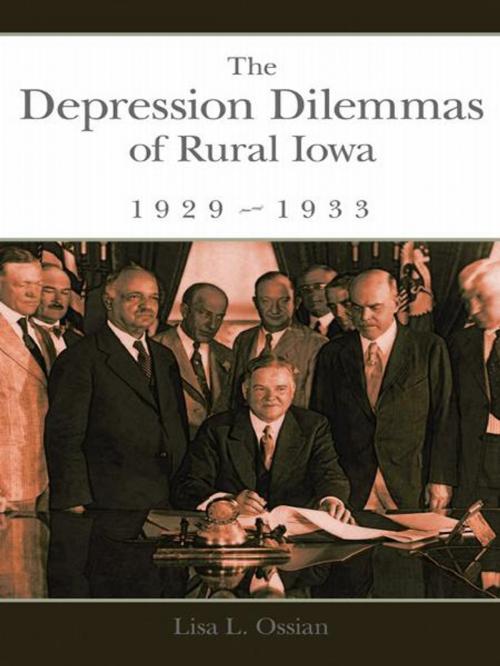| Author: | Lisa L. Ossian | ISBN: | 9780826272683 |
| Publisher: | University of Missouri Press | Publication: | January 1, 2012 |
| Imprint: | University of Missouri | Language: | English |
| Author: | Lisa L. Ossian |
| ISBN: | 9780826272683 |
| Publisher: | University of Missouri Press |
| Publication: | January 1, 2012 |
| Imprint: | University of Missouri |
| Language: | English |
To many rural Iowans, the stock market crash on New York’s Wall Street in October 1929 seemed an event far removed from their lives, even though the effects of the crash became all too real throughout the state. From 1929 to 1933, the enthusiastic faith that most Iowans had in Iowan President Herbert Hoover was transformed into bitter disappointment with the federal government. As a result, Iowans directly questioned their leadership at the state, county, and community levels with a renewed spirit to salvage family farms, demonstrating the uniqueness of Iowa’s rural life.
Beginning with an overview of the state during 1929, Lisa L. Ossian describes Iowa’s particular rural dilemmas, evoking, through anecdotes and examples, the economic, nutritional, familial, cultural, industrial, criminal, legal, and political challenges that engaged the people of the state. The following chapters analyze life during the early Depression: new prescriptions for children’s health, creative housekeeping to stretch resources, the use of farm “playlets” to communicate new information creatively and memorably, the demise of the soft coal mining industry, increased violence within the landscape, and the movement to end Prohibition.
The challenges faced in the early Great Depression years between 1929 and 1933 encouraged resourcefulness rather than passivity, creativity rather than resignation, and community rather than hopelessness. Of particular interest is the role of women within the rural landscape, as much of the increased daily work fell to farm women during this time. While the women addressed this work simply as “making do,” Ossian shows that their resourcefulness entailed complex planning essential for families’ emotional and physical health.
Ossian’s epilogue takes readers into the Iowa of today, dominated by industrial agriculture, and asks the reader to consider if this model that stemmed from Depression-era innovation is sustainable. Her rich rural history not only helps readers understand the particular forces at work that shaped the social and physical landscape of the past but also traces how these landscapes have continued in various forms for almost eighty years into this century.
To many rural Iowans, the stock market crash on New York’s Wall Street in October 1929 seemed an event far removed from their lives, even though the effects of the crash became all too real throughout the state. From 1929 to 1933, the enthusiastic faith that most Iowans had in Iowan President Herbert Hoover was transformed into bitter disappointment with the federal government. As a result, Iowans directly questioned their leadership at the state, county, and community levels with a renewed spirit to salvage family farms, demonstrating the uniqueness of Iowa’s rural life.
Beginning with an overview of the state during 1929, Lisa L. Ossian describes Iowa’s particular rural dilemmas, evoking, through anecdotes and examples, the economic, nutritional, familial, cultural, industrial, criminal, legal, and political challenges that engaged the people of the state. The following chapters analyze life during the early Depression: new prescriptions for children’s health, creative housekeeping to stretch resources, the use of farm “playlets” to communicate new information creatively and memorably, the demise of the soft coal mining industry, increased violence within the landscape, and the movement to end Prohibition.
The challenges faced in the early Great Depression years between 1929 and 1933 encouraged resourcefulness rather than passivity, creativity rather than resignation, and community rather than hopelessness. Of particular interest is the role of women within the rural landscape, as much of the increased daily work fell to farm women during this time. While the women addressed this work simply as “making do,” Ossian shows that their resourcefulness entailed complex planning essential for families’ emotional and physical health.
Ossian’s epilogue takes readers into the Iowa of today, dominated by industrial agriculture, and asks the reader to consider if this model that stemmed from Depression-era innovation is sustainable. Her rich rural history not only helps readers understand the particular forces at work that shaped the social and physical landscape of the past but also traces how these landscapes have continued in various forms for almost eighty years into this century.















